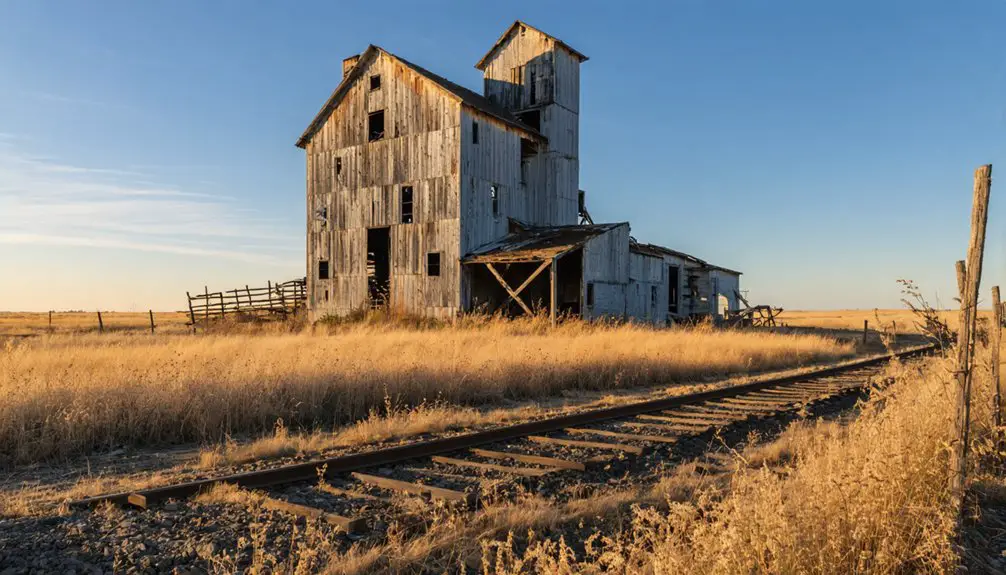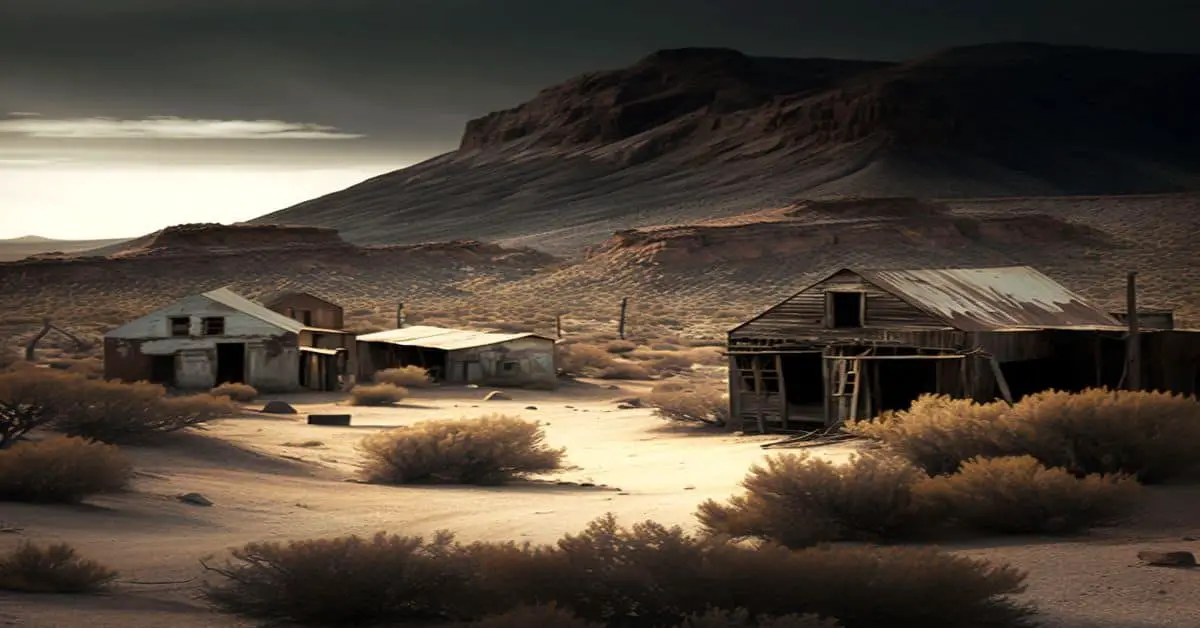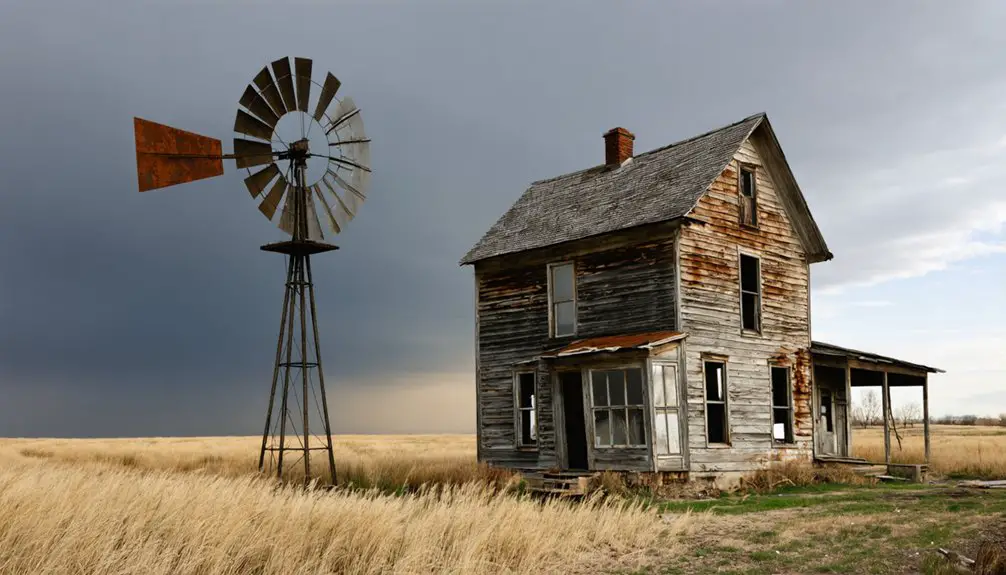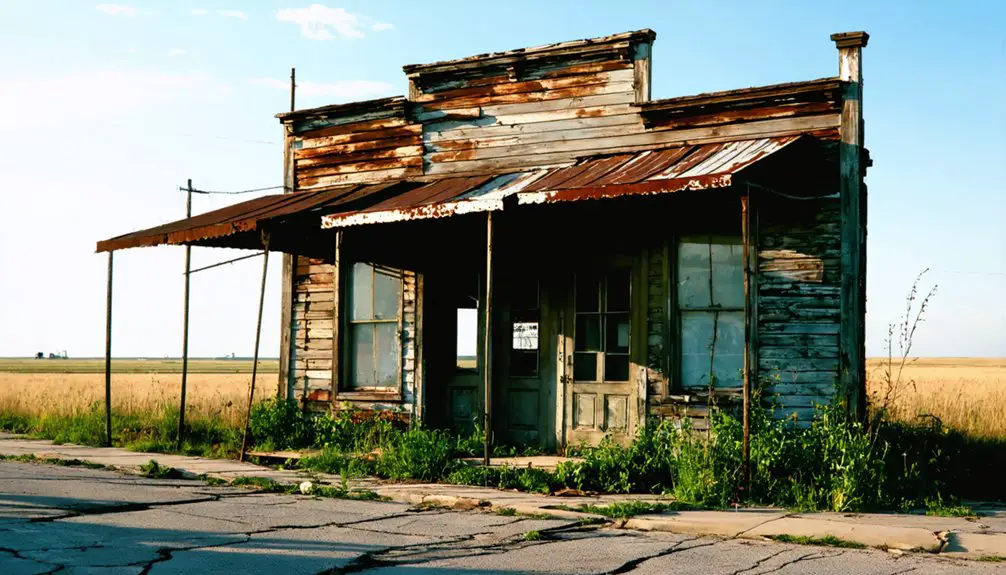You’ll find Marsland, Nebraska in the state’s Panhandle region, where it emerged as a railroad town in 1889. Named after railroad manager Thomas Marsland, the community flourished with 800 residents during its early 1900s peak, supporting cattle shipping and ice harvesting industries. Despite surviving multiple fires between 1911-1928, the town declined after the Great Depression and Burlington Railroad’s 1969 passenger service closure. Today, fewer than 30 residents preserve this living ghost town‘s architectural remnants and ranching heritage.
Key Takeaways
- Once-thriving railroad town founded in 1889, Marsland peaked at 800 residents during early 1900s before declining into a ghost town.
- Multiple devastating fires between 1911-1928 and the Great Depression contributed significantly to the town’s eventual abandonment.
- Burlington Railroad’s passenger service termination in 1969 effectively severed the town’s vital transportation connection.
- Historical buildings, including a renovated schoolhouse and original homes, remain as physical evidence of Marsland’s past.
- Currently maintains ghost town status with fewer than 30 residents, while preserving its ranching heritage amid historical structures.
The Railroad Town’s Birth and Early Promise
While many Nebraska towns sprouted alongside railroad lines in the late 1800s, Marsland’s establishment in 1889 marked a distinct convergence of railroad expansion and engineering ambition. The Chicago, Burlington, and Quincy Railroad‘s construction impact was immediately evident as the town, named after railroad manager Thomas Marsland, became a hub of activity during the building of the nearby Belmont Tunnel. The tunnel’s construction was a monumental undertaking that took two years to complete.
You’ll find the railroad significance woven into every aspect of Marsland’s early development. As workers flocked to the area, the town quickly established essential services, with businesses emerging to meet growing demands. By 1910, the bustling community had reached a population over 200 residents.
The relocation of the Corbin post office to Marsland, coupled with the emergence of merchants and craftsmen by 1890, showcased the town’s promising transformation from a simple railroad stop into a thriving community.
Peak Years of Growth and Commerce
As railroad activity intensified in the early 1900s, Marsland blossomed into a dynamic commercial center serving both regional agriculture and transportation needs.
You’d have found a bustling town of up to 800 residents, with a landscape dotted by essential businesses like blacksmiths, hotels, and a newly constructed two-story brick school. The town’s economic fluctuations reflected the rhythm of railroad commerce, particularly in cattle shipping and innovative ice harvesting operations along the Niobrara River. The town’s rich history mirrored that of Spring Ranch, with stagecoach service playing a vital early role. The prestigious Tollman family home, constructed in 1912, stood as a testament to the town’s prosperity.
Despite challenges from fires between 1911 and 1928, Marsland’s community resilience shone through as residents rebuilt and adapted.
The town’s commercial significance peaked around 1930, when freight traffic boomed and agriculture thrived. You could’ve witnessed potato farmers, ranchers, and railroad workers creating a vibrant economic ecosystem around the CB&Q line.
Life in a Nebraska Panhandle Community
Life in Nebraska’s Panhandle communities centered around strong social bonds and essential institutions that defined the rural experience. You’d find quality K-12 schools serving as cornerstones of community viability, while personal safety and affordable medical care shaped your daily quality of life.
The rural lifestyle emphasized well-maintained infrastructure and clean natural surroundings. Your level of community engagement directly impacted your sense of belonging, with participation in local organizations and leadership roles strengthening social connections. With forty percent graduates, the population was notably well-educated. The region’s extremely low 2.3 per kilometer population density created a unique sense of space and tranquility.
You’d experience the benefits of low urban congestion, proximity to family, and trustworthy neighbors. While agriculture and ranching dominated the economy, the region’s environmental amenities – including scenic landscapes and recreational opportunities – enhanced your daily experience.
Geographic isolation challenged connectivity but reinforced the tight-knit social fabric that characterized Panhandle living.
Decline and Abandonment
Once a thriving railroad community, Marsland’s decline began with a series of devastating fires that destroyed half the town’s buildings and crippled local commerce.
You’ll find that this initial blow triggered a cascade of setbacks, as business owners and residents chose to rebuild their lives elsewhere.
The economic decline intensified during the Great Depression, while severe drought conditions devastated local agriculture.
The town’s early prosperity came from railroad tunnel construction and the strategic placement along the Burlington line.
You can trace how environmental challenges, combined with shifting transportation patterns, undermined the town’s strategic importance.
When the Burlington Railroad ended passenger service in 1969, it severed a crucial lifeline for the community.
As opportunities dwindled, families steadily left for more promising locations.
Local support systems were overwhelmed as technical assistance became increasingly scarce in the remote region.
Remnants and Legacy Today
Despite its near-abandonment, Marsland’s physical remnants paint a compelling portrait of Nebraska’s rural past. You’ll find several original houses and commercial buildings still standing, including the renovated schoolhouse that anchors the town’s historical architecture.
These structures, though weathered, reveal the layout and design of this once-thriving railroad settlement. The town’s documentation through Virtual Nebraska resources helps preserve its historical significance.
With fewer than 30 residents, Marsland exists as a living ghost town where ranching continues amid the historic backdrop. The Niobrara River flows nearby, offering a serene natural setting for visitors. The town’s cultural significance extends beyond its buildings – you can explore paid adventure visits to witness how drought and economic challenges shaped the community’s destiny.
While many structures face preservation challenges, their private ownership has helped protect these tangible links to Nebraska’s Panhandle heritage, offering glimpses into the region’s settlement patterns and rural evolution.
Frequently Asked Questions
Are There Any Paranormal Activities Reported in Marsland’s Abandoned Buildings?
While you’ll find regional ghost stories around abandoned buildings, there aren’t well-documented ghost sightings or verified haunted locations in Marsland’s structures, though local folklore suggests paranormal potential in these spaces.
What Natural Disasters, Besides Drought, Contributed to Marsland’s Decline?
You’ll find that fires were the main natural disaster, with no significant flood damage recorded. Multiple fire outbreaks destroyed buildings and accelerated economic decline, forcing residents to abandon their properties.
How Many Original Marsland Structures Still Stand on Their Foundations Today?
You’ll find surprisingly few structures from the past still standing on their original foundations – only a handful of houses, some scattered commercial buildings, and the modified 1915 schoolhouse remain for historical preservation.
Did Any Famous People or Historical Events Originate From Marsland?
You won’t find any nationally famous residents from this location, though its historical significance stems from Thomas Marsland’s railroad connection and the Tollman family’s documented life in Nebraska’s western panhandle.
Can Visitors Legally Explore the Remaining Buildings in Marsland?
You can’t legally enter Marsland’s buildings without permission since they’re likely on private property. While pioneer cemeteries allow access, exploration regulations don’t extend similar rights to abandoned structures, considering building safety risks.
References
- https://kids.kiddle.co/Marsland
- https://nebraskarules.tripod.com/id11.html
- https://ominous.app/browse/site/18495
- https://en.wikipedia.org/wiki/Marsland
- https://www.ghosttowns.com/states/ne/marsland.html
- https://discovernwnebraska.com/railroad/
- http://anotherstorytotell.com/marsland-yes-there-really-is-such-a-place-in-nebraska/
- https://ruralpoll.unl.edu/sites/unl.edu.ianr.alec.rural-poll/files/media/file/successful communities.pdf
- http://govdocs.nebraska.gov/epubs/U2031/B057-2008.pdf
- https://cropwatch.unl.edu/quality-life-panhandles-strongest-selling-point-unl-study-indicates/



